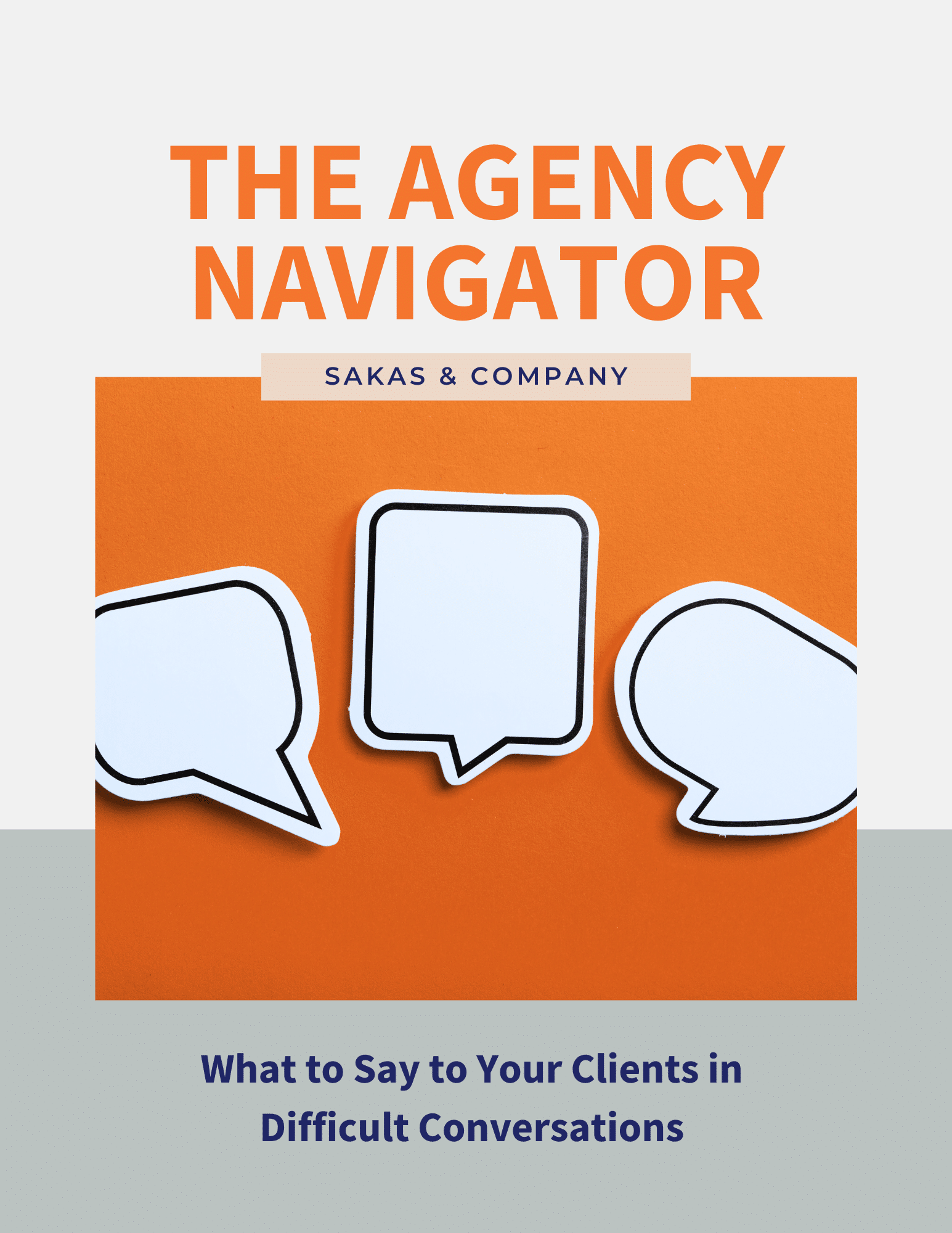An agency owner asked me: “What percentage of agency revenue should go directly to the selling process?”
As a benchmark, I typically see agency Cost of Sales range from 5% to 20% of revenue.
- The 5% cost of sales would be for a smaller agency with part-time sales help.
- The 20% cost of sales is for high-growth agencies, where the percentage will drop [somewhat] as the agency grows.
What does and doesn’t count in the percentage? Read on, to look at where the money goes—including how to calculate your agency’s sales expense as a percentage of revenue—and how to delegate the monthly calculation process. [Last updated: July 2025]
Where Your Agency Will Spend Money on Sales
What are typical categories I’m including in the 5-20% benchmark figure? Consider:
- Salary and benefits for each salesperson
- Compensation for non-salespeople providing sales support (pro-rated accordingly, including the agency owner’s sales activities)
- Sales commissions and bonuses
- Referral fees, paid to employees or outside entities
- Non-billable travel expenses specifically focused on sales
- Taking the client to dinner
Talk to your accountant for the latest on what’s deductible, and how to track everything. For example, if you’re in the U.S., entertainment expenses are no longer deductible.
What doesn’t go into the 5-20% Cost of Sales benchmark?
These categories would NOT go into the 5-20% figure:
- Pro-rated compensation for an employee’s non-sales activities
- Advertising spending, including promotional products
- Sponsorships connected to sales, including trade shows and other events
Can your agency spend too much on sales? Absolutely…
How Much is Too Much to Spend on Sales?
Your agency is likely over-paying for sales help if you’re spending more then 20% of revenue on sales.
When an Executive Coaching client drafted a sales comp plan that put the figure at more than 25%, I recommended the agency owner raise the quotas rather than pay that much, considering that it was eroding his net profit margins below my 20-30% benchmark.
Is there an exception, where it’s OK to spend more than 20% in Cost of Sales? Potentially, when you hire your first non-owner salesperson. If you weren’t paying yourself a sales commission, your revenue percentage toward sales will increase dramatically—but that’s because you were under-allocating before.
Likewise, you’ll temporarily pay a higher percentage before the salesperson starts getting results. Be sure to use a new-hire ramp-up plan, to ensure you don’t hold onto an ineffective salesperson too long.
Want to find your agency’s current Cost of Sales? Read on for my step-by-step tutorial.
[TUTORIAL] How to Calculate Your Agency’s Cost of Sales
Note: Share this with your head of finance or virtual CFO. They may have a process already; it not, this will help them get started.
Follow these steps to calculate your agency’s current Cost of Sales:
- Pull up your accounting software, and the list of categories to include and exclude (from above).
- Run a Profit & Loss (P&L) report, which will list revenue and expenses by various categories. As a starting point, consider looking at the last fiscal year, the current year to date (YTD), and the past 12 months.
- Identify your total revenue for the period. Depending on your software and how your accountant set up the Chart of Accounts, this might be called Total Sales, Total Income, Revenues, or Gross Profit. In QuickBooks, I use Gross Profit. Why? Because it subtracts Cost of Goods Sold (COGS), including “pass-through expenses” like media buys and printing; aside from markup, this is revenue you don’t hold onto.
- Identify your total sales expenses for the period. Use the categories above to guide what to include and exclude. You may need to dig into specific employees’ compensation, and may need to pro-rate it. You may also need to run another report to fully calculate your own compensation, if you take some in the form an owner’s “draw” rather than solely via P&L expenses.
- Divide the sales-related expenses by the total revenue. This is your sales expense as a percentage of sales—and you can compare it to the 5-20% benchmark.
- Repeat the process for other time periods, to ensure you aren’t over- or under-counting things.
- Reflect on whether your current results match the amount you’re spending on sales. If you’re over-performing, congrats! And if you’re under-performing, you’ll need to regroup on what to change.
Is there an easier way to calculate this? Yes, if you outsource it to your head of finance:
- Ask your accountant for advice on creating a custom report.
- Or ask your operations lead (or your accountant) to calculate this for you each month. But be sure your team is using the same inputs to calculate the percentage each time.
How Often Should You Review Your Cost of Sales?
I recommend including Cost of Sales in your monthly financial review. This helps you see changes quickly, even if you’re ultimately focused on what happens over the entire year.
Keep in mind that the Cost of Sales percentage will fluctuate dramatically on a month to month basis—and that’s OK. For instance, a spike in revenue would show a [temporarily] lower Cost of Sales… and you’d see the opposite if revenue dropped in a particular month. Ultimately, you’re looking for unexplained patterns—for instance, several months of a high Cost of Sales, due to lack of new sales.
Whomever calculates the numbers, don’t delegate reviewing the results. If you don’t love numbers, it’s all the more reason to review them each month. Otherwise, you risk seeing problems when it’s too late to fix them.
Should you consider factors beyond just percentages? Yes—read on.
Other Factors: Going Beyond Sales as a Percentage of Revenue
Beyond percentages, I typically look at sales investment based on each agency’s unique “Values, Goals, and Resources” factors:
- Headcount: It’s rare for agencies above 25 people to not have a full-time [non-owner] salesperson.
- Owner Preference: If the partner(s) dislike sales, they tend to hire-out sales sooner. Or they hire someone in a sales support role (e.g., a business development representative or a sales coordinator), so one of the partners can focus on closing deals.
- Growth Goals: Agencies seeking to grow more than 30% a year tend to hire sales help sooner, and tend to have multiple salespeople.
- Marketing Support: Is the salesperson expected to prospect all or most of their leads, or is there strong marketing support for lead-gen? You need more salespeople when you aren’t handing them leads to work. Does the agency have robust nurtures and lead scoring, or is the salesperson on their own when it comes to automation?
- Client Model: I generally recommend that agencies have 10-20 active clients, since agencies with higher client counts (especially 30+ clients) tend to be less profitable. If an agency is focused on a high-volume model, they’ll tend to have a multi-person sales team to support the need to regularly close a high volume of leads. You also need to invest more in sales when an agency is project-based rather than retainer-based.
- Conversion Rates: I recommend aspiring to a 50-70% proposal-to-close rate. If it’s significantly below 20%, the agency is probably doing too many proposals for unqualified prospects (or charging too much for their target market), or isn’t otherwise positioned well. And if it’s 90-100%, the agency is likely undercharging.
- Other Fees: Is the agency paying referral fees (to outside partners and/or non-sales employees)? Are there other percentages along the way that make the sales costs add up? (Typically, agencies pay a lower commission to the salesperson when it’s a referred-in or otherwise inbound lead.) Is the agency leasing the salesperson’s car (rarely a good idea)?
Every agency is unique; you might choose to consider other factors, too.
Independent Agencies vs. the Holding Companies
My work focuses primarily on independent agencies. Holding company agencies may choose to spend more on sales, especially if they’re pursuing RFPs or other “pitch free ideas” situations… which is part of why their net profits are often lower than my 20-30% benchmark for independent agencies.
How Can Agencies Reduce Their Cost of Sales?
Is your current Cost of Sales too high, relative to the results you’re seeing? See my followup article, on how to spend less on sales. I look at 12+ different ways to you can reduce your Cost of Sales, including some tips that are relatively easy to implement in the coming month.
Question: What changes will you make, now that you know how your agency’s Cost of Sales compares to the 5-20% benchmark?


